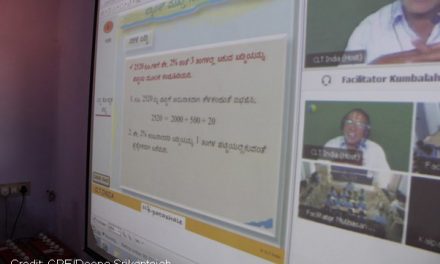This blog was written by Mary Burns, a technology and professional development specialist at Education Development Center. She helps Ministries of Education, universities and schools design and deliver online and face-to-face education programmes.
Perhaps like no other crisis, COVID-19 has highlighted the role of technology in education—in particular, online technologies. With almost all of their students out of school, over 90 percent of the world’s high-income countries and 60% of upper-middle income countries turned to online learning to provide educational continuity to their students. Understandably so. No other distance technology medium combines so many “channels” of learning—text, audio, video, multimedia. No other distance education medium can approximate the classroom experience and connect learners in real-time to their teacher, to each other, and to expertise across the globe.
However, online learning during the COVID-19 pandemic has struggled under the weight of such expectations and failed to live up to its considerable potential. This post examines the gaps between the potential of and recent performance of online education as part of the COVID19 response.
For many learners online education has been exclusive, not inclusive
 While most students in high and upper-middle income countries have taken part in online learning, online learning has generally benefited the “easiest to reach”—students from wealthy families and communities or in urban areas. Entities that have long integrated technology into their education system—Singapore, Estonia, South Korea, Shanghai, New Zealand, Alberta (Canada), wealthy private schools, one-to-one school districts in the U.S.—have done relatively well in terms of quickly and equitably extending online learning to a majority of students.
While most students in high and upper-middle income countries have taken part in online learning, online learning has generally benefited the “easiest to reach”—students from wealthy families and communities or in urban areas. Entities that have long integrated technology into their education system—Singapore, Estonia, South Korea, Shanghai, New Zealand, Alberta (Canada), wealthy private schools, one-to-one school districts in the U.S.—have done relatively well in terms of quickly and equitably extending online learning to a majority of students.
In contrast, providing online learning to harder-to-reach students has proved challenging. For example, in Peru—which employed a national online learning strategy, “Aprendo en Casa”—while 73 percent of households have home Internet access, fewer than 5 percent of rural households do. In the United States, most of the country’s 13,500 school districts attempted to offer some form of online learning, but in reality, many districts have struggled in real time to provide online learning to all students. However, as before the pandemic, districts with large concentrations of poor students, students with special needs, English-language learners and/or students in rural areas have been least able to access online learning during the pandemic.
Even in many of these well-resourced environments, mentioned earlier, such as New Zealand and South Korea, as in other upper- and middle-income countries, online learning has also proved to be exclusionary for poor and rural students, primary-age learners, students with special needs or who take certain types of classes.
This lack of online access and equity has resulted in the educational renaissance of an “old” analog technology—television. Across the globe, countries have leveraged high rates of TV ownership and viewership to reach all students. Ninety percent of high- and middle-income countries—all 50 U.S. states, numerous European, Middle Eastern, and Latin American countries, and China—have combined broadcast TV with online learning. The reversion to television as an educational technology tools lays bare the current weaknesses of online learning as a reliable and accessible vehicle for scaling education to all learners.
Online education has failed to impress its customer base—students
Online learning has been indeed been “disruptive”, but not in the ways technology companies and educational futurists had hoped. My own conversations with 28 mainly US-based students, though admittedly far from representative, reveals that many of our students, long presumed to be digital aficionados, are not enamoured of online learning.
One may reasonably argue that the mad scramble of emergency online teaching over the last two months cannot be compared to well-planned and designed online learning—and that is true. However, online learning suffers from a more fundamental issue: Students dislike much of the product itself, extra sleep time notwithstanding. They don’t like learning alone; they don’t like spending so much time in front of a screen; they find being online “distracting”; and they see online learning as “low quality”, “a dumbed-down version of face-to-face learning”, “an imitation of school” and “lonely.” It’s not simply that students miss their friends—they do—they especially miss being part of a community of learners. They miss the experience and structure of school and the place-based nature of learning—or as one student noted, “(being) in a place where everything is designed for learning.”
Online education has spawned a teaching crisis
Any previously held notion that online learning is ipso facto more innovative than face-to-face instruction has been dispelled by the reality of emergency online education. Online education has proved to be highly didactic and passive and has resulted in an impoverished learning experience for many students.
What we’ve seen over the last few months, across the globe, is “online education” in its most reductionist form—as a content delivery system. Students do assignments in a platform like Google Classroom or via a subscription education service. They learn alone, with occasional check-ins and office hours with teachers via a web-conferencing system. They struggle alone, too. Few students with whom I’ve talked have participated in sustained real-time instructional activities with their teachers or classmates. Where there is instruction, it is often in the form of that most traditional of pedagogies—the lecture (some live, most pre-recorded).
This absence of instruction, or the substitution of online didactic approaches by teachers who often employ learner-centered approaches in face-to-face classrooms, has its roots in the fact that many teachers have had little technology training, particularly online technologies. Consequently, teachers had to quickly decide which technologies to use and learn how to use them. This, combined with lack of careful design of online classes and professional development in online teaching, has for the most part, sidelined good pedagogy.
Within households, online education has layered new patterns of educational inequality over old ones
In education, as in health and economics, COVID-19 has disproportionately affected the poorest communities and layered one inequity over another. Across the globe, poor children are least likely to have access to technology and the Internet. They are more likely to share technology; use it for entertainment purposes versus academics; and consume versus produce content. Students from poor families are less likely to seek and receive help on schoolwork; less likely to participate in online learning; and less likely to use computers for critical thinking.
During this pandemic, the responsibility for teaching and learning has been pushed into home environments that have not been able to support students learning online. Parental engagement has long been critical to student learning but “remote learning” has amplified the role of parents as they have become their child’s de facto teachers. Yet, many parents have been unable to stay at home, leaving their children unsupervised or in charge of child care. Many parents lack the digital tools (laptop, email) to communicate with schools and lack the needed digital literacy skills to be able to engage in their child’s learning.
This crisis has laid bare the lack of readiness of online education as an equitable and quality education solution
While it’s not fair to compare well-planned online learning with the chaos of emergency online teaching, the past two-month experiment in online education has exposed many of its fault lines. Inequity has been exacerbated by the failure to ensure reliable broadband access and a technology device for every student within upper and middle-income countries; but such inequities have been most glaring in poorer countries (which is why this post does not discuss online learning in sub-Saharan Africa). The quality of online education has been degraded by treating it as an add-on to real (face-to-face) education versus as an integral part of the overall educational system. Quality has also suffered from the failure to carefully design quality online learning experiences, develop digital content and assessments designed specifically for online practice, and create the requisite supports, policies and procedures for online learning to work well.
More than any distance education technology, online learning demands much of its users. Yet we have not prepared teachers to design engaging online courses. We have not helped students and teachers learn how use online technologies, teach and learn via technology, and develop the literacies, habits of mind and behaviours to be successful participants in an online learning experience. Decades after the large-scale introduction of online learning into education systems, we still lack research on the most basic of questions—is online learning as effective as face-to-face instruction for all students and if so, under what conditions? What online practices and pedagogies best support learning in an online environment?
——————————————–
In the absence of a vaccine and large-scale testing, we can expect more disruptions to education from this and potentially other pandemics. Our experiment with emergency online education has been self-incriminating—the chaotic lunge to what has proved to be an incomplete online learning system has diluted, versus enhanced, learning for many of our students. Education systems need to redress the weaknesses of recent emergency online education and transition to a more defined, carefully designed and deliberative form of online education so it offers a quality education to all learners, not simply the most privileged.





Brilliant, thank you Mary. I couldn`t agree more with you. What I found particularly interesting is that fact that you`re putting emphasis on equity/quality and the need to take into account ALL learners.
It`s so frustrating to see what I call `digital pedagogy` completely undermined by other issues, such as connectivity and equipment, which are of course equally important. From what I`m hearing, the shortcomings of face-to-face teaching are not only being transposed online but even exacerbated. Worse many don`t seem to realise that and think that this`s how it should be!
Hi Amina,
Thanks for reading and commenting. It’s interesting because many (like the WEF) have touted the success of online learning during the pandemic. And for many, online learning has indeed worked as advertised. However, I’d venture to say that these are schools and systems that were 1:1 districts and where teachers and students were already well prepared to teach and earn via technology. For the vast majority (the rest of the world), online education has been uneven, disappointing and unavailable. I can’t think of another technology that so exacerbates the digital divide. Disappointing because if designed well and if classes are facilitated by caring, knowledgeable online instructors, I think online learning is by far the superior distance education medium for older students and adults. We have a lot of work to do!
Mary
Great! Anyone who reads this article will find this extremely valuable. I’m glad I came across this. Thank you for sharing your knowledge!